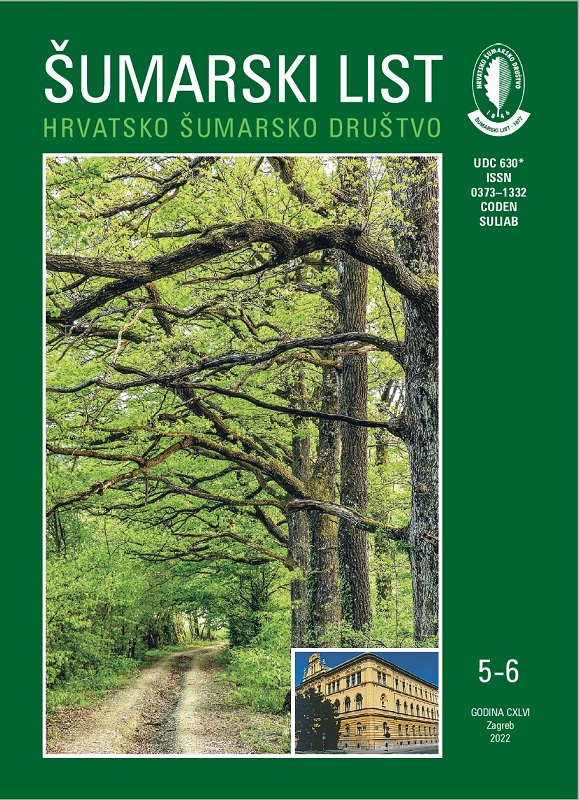
broj: 5-6/2022
pdf (11,37 MB) |
|
||||||||||||||
| RIJEČ UREDNIŠTVA | ||
| Uredništvo | ||
| XV World Forestry Congress pdf HR EN | 173 | |
| IZVORNI ZNANSTVENI ČLANCI | ||
| Krunoslav Sever, Davor Poljaković, Tomislav Karažija, Boris Lazarević, Antonia Vukmirović, Mario Šango, Željko Škvorc | UDK 630* 815 + 847 (001) https://doi.org/10.31298/sl.146.5-6.1 | |
| Growth of common beech (Fagus sylvatica L.) saplings under the impact of suboptimal mineral nutrition pdf HR EN | 175 | |
| Jelena Kolić, Renata Pernar, Ante Seletković, Mirna Samaržija, Mario Ančić | UDK 630* 533 + 535 (001) https://doi.org/10.31298/sl.146.5-6.2 | |
| Comparison of crown damage assessment on analog and digital infrared color (CIR) aerial photographs pdf HR EN | 187 | |
| Matija Landekić, Ivan Bošnjak, Matija Bakarić, Mario Šporčić | UDK 630* 309 (001) https://doi.org/10.31298/sl.146.5-6.3 | |
| Trends and relations of occupational safety indicators in Croatian forestry pdf HR EN | 201 | |
| Mirjana Šipek, Eva Horvat, Ivana Vitasović Kosić, Nina Šajna | UDK 630* 449 (001) https://doi.org/10.31298/sl.146.5-6.4 | |
| Presence of alien Prunus serotina and Impatiens parviflora in lowland forest fragments in NE Slovenia pdf HR EN | 215 | |
| PREGLEDNI ČLANCI | ||
| Ivana Gašparović, Željko Španjol, Boris Dorbić, Nikola Vrh, Ivan Tolić, Milan Vojinović, Sanja Stevanović | UDK 630* 272 https://doi.org/10.31298/sl.146.5-6.5 | |
| Landscape and ecological valorisation in the context of protection and revitalisation of Hober forest park in Korčula, the Republic of Croatia pdf HR EN | 225 | |
| STRUČNI ČLANCI | ||
| Vladimir Stojanović, Damir Demonja, Maja Mijatov, Jelena Dunjić, Sanja Tišma | UDK 630* 611 https://doi.org/10.31298/sl.146.5-6.6 | |
| Concept of ecotourism development in UNESCO biosphere reserves: Case studies from Croatia and Serbia pdf HR EN | 243 | |
| Irena Papazova-Anakieva, Sterja Načeski, Margarita Georgieva | UDK 630* 272 + 523 https://doi.org/10.31298/sl.146.5-6.7 | |
| The health condition of trees in dendropark at Faculty of Forestry – Skopje with a special focus on fungal diseases and insect pests pdf HR EN | 255 | |
| Summary The Dendropark at the Faculty of Forestry in Skopje, North Macedonia, was established as an ‘outdoor museum’ with a collection of forest trees and shrub vegetation. The collection was planted in 1950 on the area of 4.05 ha, and includes 336 taxa from native Macedonian and Balkan endemic dendroflora and introduced species from around the world. The Dendropark, like the other botanical gardens all over the world, offers a unique resource that facilitate earlier detection of the potential invasive threats to forest tree species. The inventoried population includes 444 trees belonging to 43 families. The three most represented families are Pinaceae with 21 species (19.4% of the inventoried plants), Cupressaceae with 16 species (15.8%) and Rosaceae with 18 species (7.4%). The 2014 survey indicated that 33.8% of the total number of trees were rated with good health status, 1.8% as very good, 31.1% rated as fair, while 24.5% were poor. Approximately 4.1% were rated to be in a critical state (in a state of decline), and 4.7% of trees were dead. The assessment of health status of plants in the Dendropark could be used as a valuable asset to planners and decision makers and provides information about the quality, quantity and location of natural resources in urban areas. Identifying changes in plant species composition and presence of invasive pests and diseases helps maintaining healthy urban forests. Key words: Platanus orientalis L.; powdery mildews; bark beetles | ||


